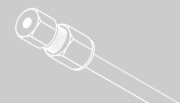Beskrivelse
Normal phase and hydrophilic interaction liquid chromatography (HILIC) are primarily used to separate polar and hydrophilic compounds. In reversed phase mode very polar compounds are often not sufficiently retained in low percent organic, or even in 100% aqueous mobile phase. The order of elution in normal phase is opposite that found in reversed phase for the same mixture of compounds. Although non-polar organic mobile phases and a silica stationary phase were used traditionally in normal phase LC, today most separations are performed with aqueous-organic mobile phases and a more polar-bonded stationary phase. This mode of HPLC is now commonly referred to as HILIC, hydrophilic interaction liquid chromatography.
By using an amide or amino bonded phase column, polar compounds can be retained by a normal phase or hydrophilic interaction chromatography retention mechanism. Typical mobile phases in HILIC are aqueous buffers with organic modifiers – primarily acetonitrile. In contrast to the retention behavior in reversed phase, in HILIC, solutes will be retained longer when increasing the percent acetonitrile.
Applications
- Typical applications for HILIC are
- Analysis of polyols, carbohydrates, or vitamins
- Characterization of protein glycosylation by fluorescence or mass spectrometric detection
- Separation of polar peptides, e.g. after enzymatic digestion of proteins (peptide mapping)
- Analysis of polar drugs and separation of drug metabolites
- LC/MS analysis of polar compounds
TSKgel HILIC Columns
TSKgel normal phase/HILIC stationary phases are uniformly bonded silica-based packing materials with narrow pore size distributions and well-defined particle sizes to ensure high performance. TSKgel HILIC columns are available with covalently bonded carbamoyl and amino phases and both phases are stable in 100% organic eluents.
| TSKgel Column | Particle Size (µm) | Benefit |
| Amide-80 | 3, 5, 10 | Bonded phase does not react with reducing sugars; possess superior stability in aqueous/organic solvent systems |
| NH2-100 | 3 | Bonded phase is more stable than conventional amino phases due to a special endcapping prior to introduction of aminoalkyl groups; can react with a reducing sugar to form a Schiff base |
For flere detaljer og pris, kontakt venligst MD Scientific via e-mail: info@md-scientific.dk eller telefon: 7027 8565.

